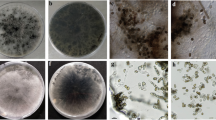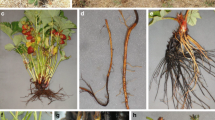Abstract
Members of the Botryosphaeriaceae, in particular Lasiodiplodia theobromae, Neofusicoccum parvum, N. mangiferum and Botryosphaeria dothidea, commonly cause stem cankers, dieback and stem end rot of mangoes worldwide. In the current study, eight taxa of Botryosphaeriaceae were identified as canker-associated fungi, pathogens, potential pathogens or endophytes of mangoes in the Kimberley, Australia. These include Neoscytalidium novaehollandiae, Ne. dimidiatum, Pseudofusicoccum adansoniae, P. ardesiacum, P. kimberleyense, Lasiodiplodia sp. 1, L. iraniensis and L. pseudotheobromae. The pathogenicity of a selection of these species toward fruit and branches was tested. All were pathogenic to mango in comparison to the control, with Lasiodiplodia spp. being the most pathogenic. It appears that either geographic isolation or the unique growing conditions in the Kimberley may have provided an effective barrier to the acquisition or establishment of known botryosphaeriaceous pathogens. Wounds caused by mechanical pruning may provide an entry point for infection, whilst severe pruning may increase plant stress.




Similar content being viewed by others
References
Abdollahzadeh, J., Javadi, A., Mohammadi Goltapeh, E., Zare, R., & Phillips, A. J. L. (2010). Phylogeny and morphology of four new species of Lasiodiplodia from Iran. Persoonia, 25, 1–10.
Adair, R. J., Burgess, T., Serdani, M., & Barber, P. (2009). Fungal associations in Asphondylia (Diptera: Cecidomyiidae) galls from Australia and South Africa: implications for biological control of invasive acacias. Fungal Ecology, 2, 121–134.
Ahimera, N., Driever, G. F., & Michailides, T. J. (2003). Relationships among propagule numbers of Botryosphaeria dothidea. Latent infections, and severity of panicle and shoot blight in pistachio orchards. Plant Disease, 87, 846–853.
Alves, A., Crous, P. W., Correia, A., & Phillips, A. J. L. (2008). Morphological and molecular data reveal cryptic speciation in Lasiodiplodia theobromae. Fungal Diversity, 28, 1–13.
Andjic, V., Barber, P. A., Carnegie, A. J., Hardy, G. E. StJ., Wingfield, M. J., & Burgess, T. I. (2007). Phylogenetic reassessment supports accommodation of Phaeophleospora and Colletogloeopsis from eucalypts in Kirramyces. Mycological Research, 111, 1184–1198.
Bally, I. S. E., Harris, M., & Whiley, A. W. (2000). Effect of water stress on flowering and yield of ‘Kensington Pride’ mango (Mangifera indica L). Acta Horticulturae (ISHS), 509, 277–282.
Begoude, B. A. D., Slippers, B., Wingfield, M. J., & Roux, Y. (2010). Botryosphaeriaceae associated with Terminalia catappa in Cameroon, South Africa and Madagascar. Mycological Progress, 9, 101–123.
Brown, E. A., & Hendrix, F. F. (1981). Pathogenicity and histopathology of Botryosphaeria dothidea on apple stems. Plant Disease, 71, 375–379.
Brown-Rytlewski, D. E., & McManus, P. S. (2000). Virulence of Botryosphaeria dothidea and Botryosphaeria obtusa on apple and management of stem cankers with fungicides. Plant Disease, 84, 1031–1037.
Burgess, T. I., Barber, P. A., & Hardy, G. E. StJ. (2005). Botryosphaeria spp. associated with eucalypts in Western Australia, including the description of Fusicoccum macroclavatum sp. nov. Australasian Plant Pathology, 34, 557–567.
Burgess, T. I., Barber, P. A., Mohali, S., Pegg, G., de Beer, W., & Wingfield, M. J. (2006). Three new Lasiodiplodia spp. from the tropics, recognized based on DNA sequence comparisons and morphology. Mycologia, 98, 423–435.
Burgess, T. I., Sakalidis, M. L., & Hardy, G. E. StJ. (2006). Gene flow of the canker pathogen Botryosphaeria australis between Eucalyptus globulus plantations and native eucalypt forests in Western Australia. Austral Ecology, 31, 559–566.
Carbone, I., Anderson, J. B., & Kohn, L. M. (1999). A method for designing primer sets for the speciation studies in filamentous ascomycetes. Mycologia, 95, 553–556.
Cooke, A. W.,van der Kruyssen, A., & Johnson, G. I. (1998). The effect of commercial pruning on colonisation of mango by endophytic Dothiorella species. In L. M. Coates, G. I. Hofman, G. I. Johnson, & E. Highley, (Eds.), Disease control and storage life extension in fruit (pp. 128–130). ACIAR Proceedings.
Crous, P. W., Slippers, B., Wingfield, M. J., Rheeder, J., Marasas, W. F. O., Philips, A. J. L., et al. (2006). Phylogenetic lineages in the Botryosphaeriaceae. Studies in Mycology, 55, 235–253.
Cunnington, J. H., Priest, M. J., Powney, R. A., & Cother, N. J. (2007). Diversity of Botryosphaeria species on horticultural plants in Victoria and New South Wales. Australasian Plant Pathology, 36, 157–159.
DAFF (2008). Australian Horticulture Fact Sheet.
Dakin, N., White, D., Hardy, G. E. StJ., & Burgess, T. I. (2009). The opportunistic pathogen, Neofusicoccum australe, is responsible for crown dieback of peppermint (Agonis flexuosa) in Western Australia. Australasian Plant Pathology, 39, 202–206.
Damm, U., Crous, P. W., & Fourie, P. H. (2007). Botryosphaeriaceae as potential pathogens of Prunus species in South Africa, with descriptions of Diplodia africana and Lasiodiplodia plurivora sp. nov. Mycologia, 99, 664–680.
Felsenstein, J. (1985). Confidence intervals on phylogenetics: an approach using bootstrap. Evolution, 39, 783–791.
Gardes, M., & Bruns, T. D. (1993). ITS primers with enhanced specificity for basidiomycetes— application to the identification of mycorrhizae and rusts. Molecular Ecology, 2, 113–118.
Graham, G. C., Meyers, P., & Henery, R. J. (1994). A simplified method for preparation of fungal DNA for PCR and RAPD analysis. Biotechniques, 16, 48–50.
Hillis, D. M., & Huelsenbeck, J. P. (1992). Signal, noise and reliability in molecular phylogenetic analysis. The Journal of Heredity, 83, 189–195.
Jacobs, K., Bergdahl, D. R., Wingfield, M. J., Halik, S., Seifert, K. A., Bright, D. E., et al. (2004). Leptographium wingfieldii introduced into North America and found associated with exotic Tomicus piniperda and native bark beetles. Mycological Research, 108, 411–418.
Johnson, G. I. (1993) The biology and control of stem end rot of mango. Dissertation, University of Queensland.
Johnson, G. I. (1997). Mango disease losses: Balancing economy and ecology Acta Horticulturae. Paper presented at the International Mango Conference, Tel Aviv.
Johnson, G. I. (2008). Status of mango postharvest disease management R & D: Options and solutions for the Australian mango industry. Horticulture Australia Final report for project MG08017, 1–130.
Johnson, G. I.,van der Kruyssen, A.,Gosbee, M. J.,McAulliffe, D., & Mayne, D. (1997). Factors affecting the colonisation of mango by Dothiorella dominicana (syn. Fusicoccum aesculi) : a model system. Paper presented at the Disease Control and Storage Life Extension in Fruit, Chiang Mai, Thailand
Kogel, K.-H., Franken, P., & Hückelhoven, R. (2006). Endophyte or parasite-what decides? Current Opinion in Plant Biology, 9, 358–363.
Kostermans, A. J. G. H., & Bompard, J. M. (1993). The Mangoes Their Botany, Nomenclature, Horticulture and Utilisation. London: Academic.
Mohali, S. (1993). Estudio histologico de Madera de pino caribe con manchado azul causado por Botryodiplodia theobromae. Fitopatologia Venezolana, 6, 14–17.
Mohali, S., Encinas, O., & Mora, N. (2002). Manchado azul en madera de Pinus oocarpa y Azadirachta indica en Venezuela. Fitopatologia Venezolana, 15, 30–32.
Pavlic, D., Slippers, B., Coutinho, T. A., & Wingfield, M. J. (2007). Botryosphaeriaceae occurring on native Syzygium cordatum in South Africa and their potential threat to Eucalyptus. Plant Pathology, 56, 624–636.
Pavlic, D., Wingfield, M. J., Barber, P., Slippers, B., Harder, G. E. S., & Burgess, T. I. (2008). Seven new species of the Botryosphaeriaceae from baobab and other native trees in Western Australia. Mycologia, 100, 851–866.
Phillips, A. J. L. (1998). Botryosphaeria dothidea and other fungi associated with excoriose and dieback of grapevines in Portugal. Journal of Phytopathology, 146, 327–332.
Ploetz, R. C., Benscher, D., Vazquez, A., Colls, A., Nagel, J., & Schaffer, B. (1996). A reexamination of mango decline in Florida. Plant Disease, 80, 664–668.
Prakash, O., & Eckert, J. W. (2001). Twig die back disease of mango (Mangifera indica L.) caused by Botryosphaeria ribis: new for California. Biological Memoirs, 27, 71–72.
Punithalingam, E. (1980). Plant diseases attributed to Botryodiplodia theobromae Pat. Bibliotheca Mycologia, 71, 1–123.
Ramos, L. J., Davenport, T. L., McMillan, R. T., Jr., & Lara, S. P. (1997). The resistance of mango (Mangifera indica) cultivars to tip dieback disease in Florida. Plant Disease, 81, 509–514.
Ramos, L. J., Lara, S. P., McMillan, R. T. J., & Narayanan, K. R. (1991). Tip dieback of mango (Mangifera indica) caused by Botryosphaeria ribis. Plant Disease, 75, 315–318.
Ray, J. D., Burgess, T. I., & Lanoiselet, V. M. (2010). First record of Neoscytalidium dimidiatum and N. novaehollandiae on Mangifera indica and N. dimidiatum on Ficus carica in Australia. Plant Disease Notes, 5, 48–50.
Regina, S. R., David, D. D., & Rusty, J. R. (2001). Fungal symbiosis from mutualism to parasitism: who controls the outcome, host or invader? The New Phytologist, 151, 705–716.
Sakalidis, M. L., Hardy, G. E. StJ., & Burgess, T. I. (2011). Endophytes as potential pathogens of the baobab species Adansonia gregorii: a focus on the Botryosphaeriaceae. Fungal Ecology, 4, 1–14.
Seiber, T. N. (2007). Endophytic fungi in forest trees: are they mutualists? Fungal Biology Reviews, 21, 75–89.
Slippers, B., Johnson, G. I., Crous, P. W., Coutinho, T. A., Wingfield, B. D., & Wingfield, M. J. (2005). Phylogenetic and morphological re-evaluation of the Botryosphaeria species causing diseases of Mangifera indica. Mycologia, 97, 99–110.
Slippers, B., & Wingfield, M. J. (2007). Botryosphaeriaceae as endophytes and latent pathogens of woody plants: diversity, ecology and impact. Fungal Biology Reviews, 21, 90–106.
Smith, D. R., & Stanosz, G. R. (2001). Molecular and morphological differentiation of Botryosphaeria dothidea (anamorph Fusicoccum aesculi) from some other fungi with Fusicoccum anamorphs. Mycologia, 93, 505–515.
Smith, H., Wingfield, M. J., Crous, P. W., & Coutinho, T. A. (1996). Sphaeropsis sapinea and Botryosphaeria dothidea endophytic in Pinus spp. and Eucalyptus spp. in South Africa. South African Journal of Botany, 62, 86–88.
Smith, H., Wingfield, M. J., & Petrini, O. (1996). Botryosphaeria dothidea endophytic in Eucalyptus grandis and Eucalyptus nitens in South Africa. Forest Ecology and Management, 89, 189–195.
Stone, J. K., Polishook, J. D., & White, J. F. J. (2004). Endophytic Fungi. In G. B. G. Mueller & M. Foster (Eds.), Measuring and Monitoring biodiversity of fungi. Inventory and monitoring methods (pp. 241–270). Boston: Elsevier Academic Press.
Swofford, D. L. (2003). PAUP* Phylogenetic Analysis Using Parsinomy (*and other methods). Sinauer Associates
Taylor, K., Barber, P. A., Hardy, G. E. StJ., & Burgess, T. I. (2009). Botryosphaeriaceae from tuart (Eucalyptus gomphocephala) woodland, including descriptions of four new species. Mycological Research, 113, 337–353.
White, T. J., Bruns, T., Lee, S., & Taylor, J. (1990). Amplification and direct sequencing of fungal ribosomal RNA genes for phylogenetics. In M. A. Innes, D. H. Gelfand, J. J. Sninsky, & T. J. White (Eds.), PCR Protocols: A Guide to Methods and Applications (pp. 315–322). San Diego: Academic.
Willingham, S. L., Coates, L. M., Cooke, A. W., & Dean, J. R. (2004). Tree vigour influences disease susceptibility of ‘Hass’ avocado fruits. Australasian Plant Pathology, 33, 17–21.
Willingham, S. L., Pegg, K. G., Coates, L. M., Cooke, A. W., Dean, J. R., Langdon, P. W. B., et al. (2001). Field management of avocado postharvest diseases. Acta Horticulturae, 553, 435–438.
Acknowledgements
We would like to thank Diane White and Leila Eshraghi for their assistance in sequencing some of the isolates. Greg Johnson is thanked for sharing his wealth of knowledge about mango diseases in Australia. Anonymous reviewers are thanked for their invaluable contribution to this manuscript.
Author information
Authors and Affiliations
Corresponding author
Rights and permissions
About this article
Cite this article
Sakalidis, M.L., Ray, J.D., Lanoiselet, V. et al. Pathogenic Botryosphaeriaceae associated with Mangifera indica in the Kimberley Region of Western Australia. Eur J Plant Pathol 130, 379–391 (2011). https://doi.org/10.1007/s10658-011-9760-z
Accepted:
Published:
Issue Date:
DOI: https://doi.org/10.1007/s10658-011-9760-z




